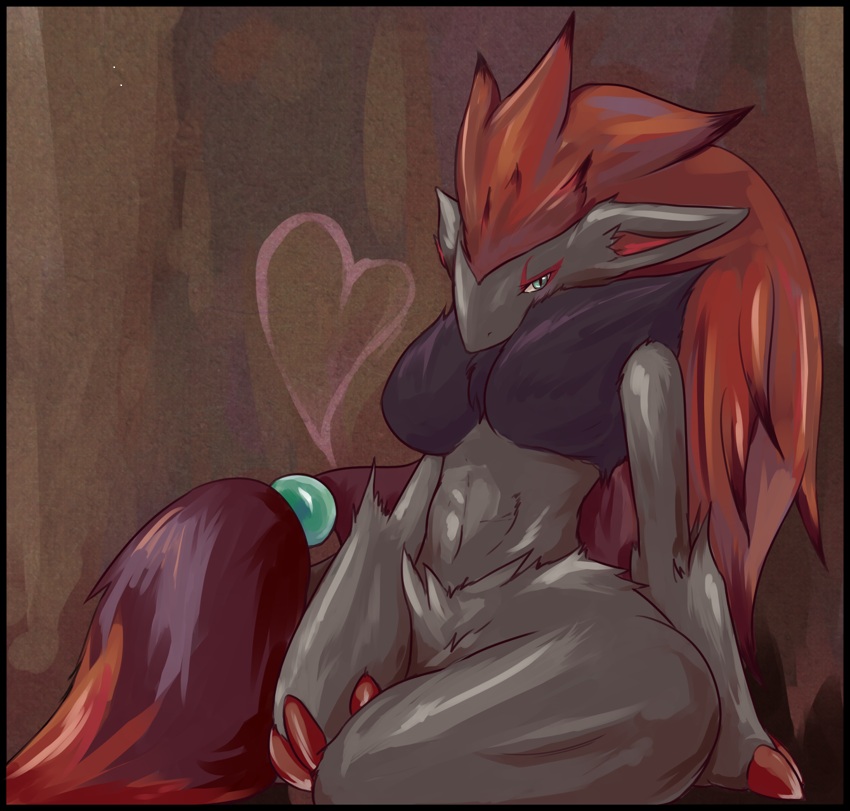

 to display an image.
to display an image.| Pictures | Information: #571 Level: 50 Type: Dark Ability: Illusion Height:5'3" (1.6m) Weight:178.8lbs (81.1 kg) Dex Color: Grey Catch Rate: 45 (5.9%) ~Base States~ HP:60 Attack:105 Defence: 60 SP. Attack:120 SP. Defence:60 Speed:105 Total:510 ~type Effects~ Damage Normal by: Normal x1, Flying x1, Poison x1, Groundx1, Rock x1, Steel x1, Fire x1, Water x1, Grace x1, Electric x1, Ice x1, Dragon x1. Weak To: Fighting x2, Bug x2. Immune to: Psychic x0. Resistant To: Ghost ½x, Dark ½×. ~Attacks~ Pursuit: (type-dark), (Cat-Physical), (Power-40), (Acc-100%) (PP-20) EffectIf the target Pokémon is switched out on the turn Pursuit is used, Pursuit's power becomes 80 and will deal damage before the Pokémon is switched out. This does not apply if used on an ally switching out. ~Biology~ Physiology:Zoroark is a bipedal fox-like Pokémon, and mainly grayish-brown in coloration with crimson and black accents. It has a pointed snout and ears, the insides of which have red coloration. Zoroark also has some red rimming its eyes and mouth. Zoroark has a large, voluminous mane, primarily red in coloration but with black tips. The mane also somewhat resembles a ponytail, as a teal bangle down its length separates a mass of the mane from the lower portion. Zoroark has a black ruff on its upper body, pointed at the shoulders from which its arms extend. Its upper arms are thin, whereas its lower arms, while still slim, are bulkier. The arms have spiky extensions of fur at the elbows, and Zoroark's three claws, as well as the claws on its feet, are red in coloration. Zoroark's eyes are red-rimmed with light blue irises Special abilities:Zoroark are capable of creating illusions that are indistinguishable from reality, deluding many people simultaneously. However, unlike Pokémon that are able to Transform, Zoroark is incapable of physically changing itself into another form; it is merely capable of casting illusions. Thus, Zoroark's type and stats do not change when casting an illusion, and it is unable to use the moves or Abilities of the Pokémon that it is pretending to be. They can, however, make convincing illusions of attacks, and these illusions are extremely realistic, to the point that even cameras are fooled and one may believe they're being physically affected, though the illusion does not have any direct physical effect. Zoroark, along with its pre-evolution, are the only Pokémon capable of learning Night Daze. Behavior:Zoroark live in groups, where unity is strong. They are extremely protective of those they care about and are willing to go to any lengths to keep them safe, including risking their own life, and also hold grudges on those who harm their loved ones. Zoroark has the ability to create illusions to confuse foes, and will even create illusory landscapes to hide its territory. Zoroark apparently will hide their Zorua young in their mane to protect them and carry them around. Habitat:Zoroark appears to live in forests, and will create an illusory landscape to protect its den. One particular Zoroark resides in Lostlorn Forest, using its illusions to betwitch both Trainers and Pokémon to protect its lair. Pokédex entries: Bonds between these Pokémon are very strong. It protects the safety of its pack by tricking its opponents. Each has the ability to fool a large group of people simultaneously. They protect their lair with illusory scenery. |